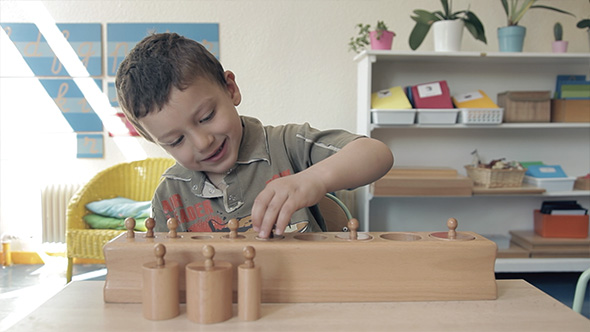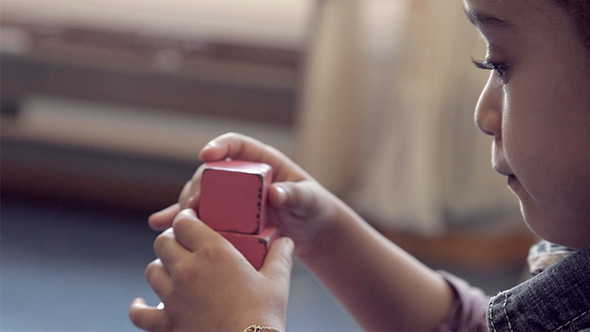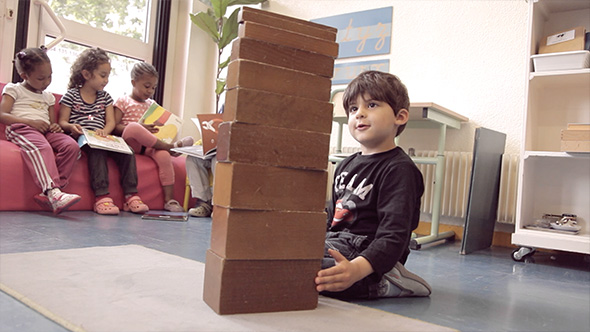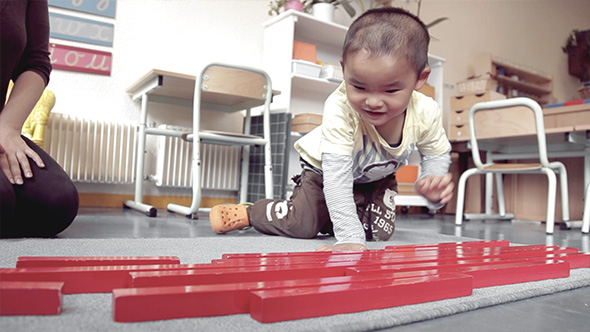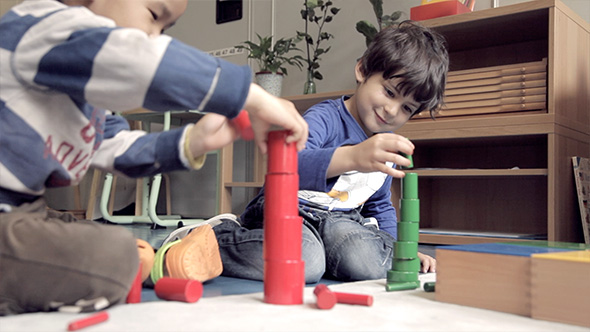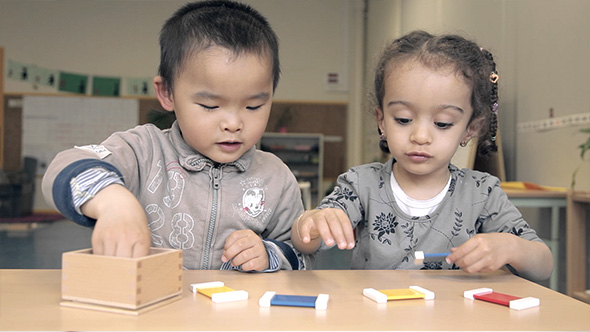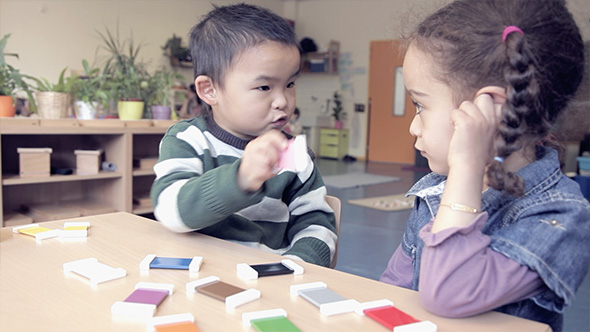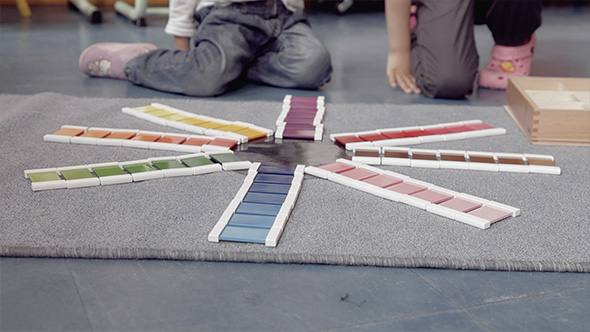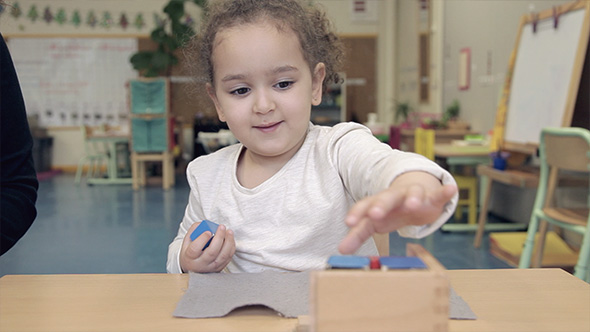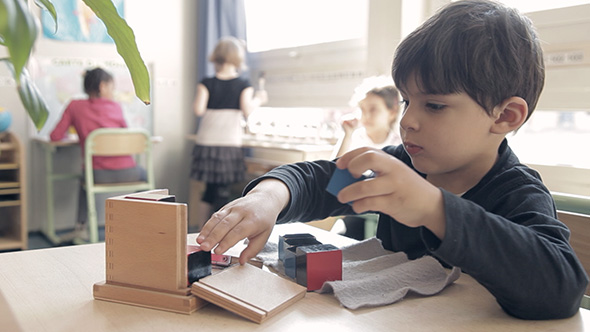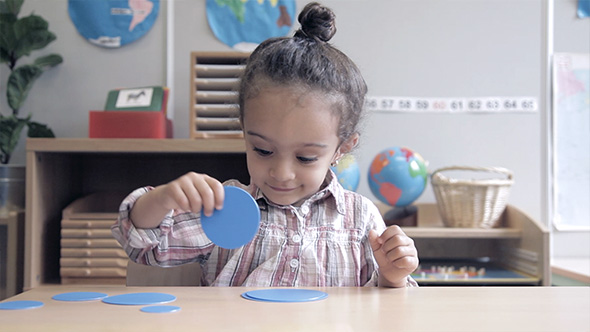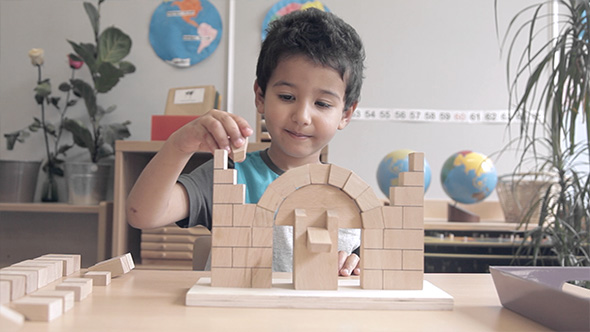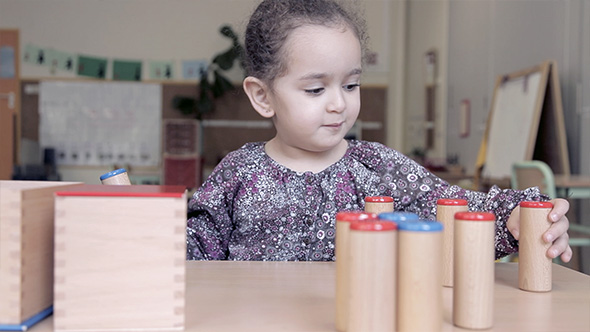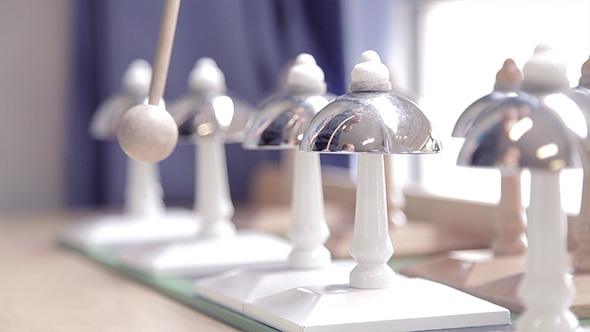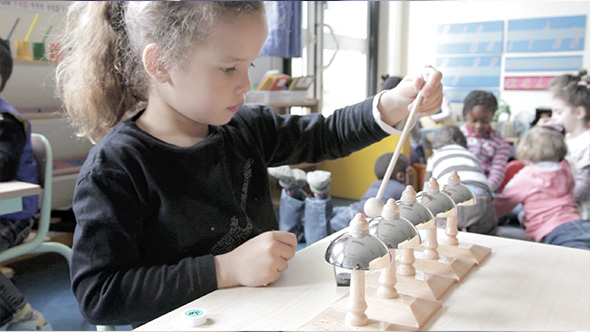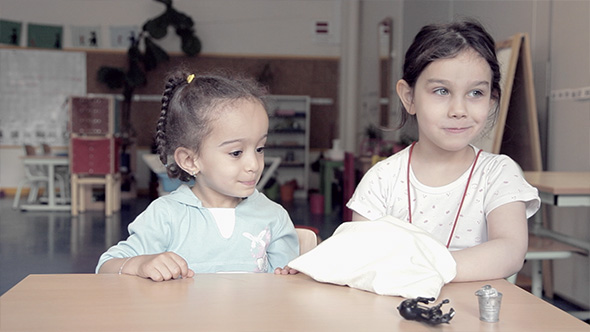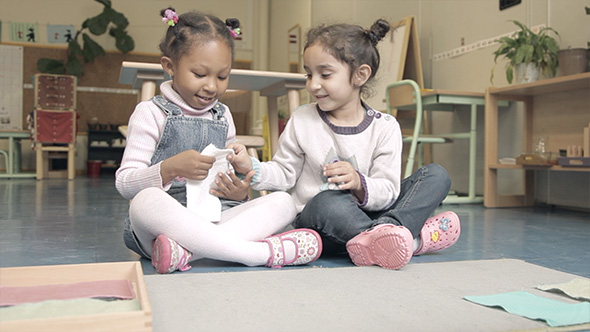Sense refinement
Young human beings possess an immature brain which is highly plastic, enabling them to assimilate a large quantity of information through their senses. All the sensory information which they receive enables them to shape and structure their intelligence. It is therefore vital, on the one hand, to facilitate the child's connection with the real world so that they can gather visual, olfactory, auditory, gustatory and tactile information and, on the other, to help them hone their sensory perception capacities in order to see, smell, touch and hear better, etc. When their senses are refined in this way, they are able to develop a more discerning, precise and subtle intelligence. We share with you here the sense refinement activities which we worked on with the children and which were selected from the pedagogical legacy of Dr Édouard Séguin and Dr Maria Montessori.
We encourage you to select the activities which suit you best and to supplement them with any activity which you consider to be pertinent. As we pursue our research, we are also continuing to develop and enrich our own practical approach, which we consider to be a starting point, not an endpoint.
Seeing better
Knobbed cylinder blocks
Knobbed cylinder blocks
From age 2½.
Objectives
Principal objective - Refinement of visual discrimination
Objective formulated to the child - Match the cylinders to the holes
Materials
Four different sets of wooden knobbed cylinder blocks.
- One block whose cylinders vary only in diameter, the height remaining constant.
- Two blocks whose cylinders vary in diameter and height.
- One block whose cylinders vary only in height, the diameter remaining constant.
These materials were designed by Dr Édouard Séguin and subsequently adopted by Dr Maria Montessori.
- State the objective verbally 'I'm going to show you how to put the cylinders back in.'
- Name the materials: 'cylinder' and 'block'.
- Give an individual presentation which is precise, logical and simple.
- Give feedback on the end result 'The cylinder fits perfectly into the hole'.
- Ask the child to do it.
Structure of the presentation
Then encourage the child to do this activity with two, and then three, sets of blocks simultaneously. When the child seems sufficiently at ease with three sets of blocks, suggest that they use all four sets at the same time. The child then makes a square with the blocks, places the cylinders in the middle and then puts the cylinders back into the correct holes.
Most of the time, when they see their older classmates doing so, the children spontaneously - and rapidly - take several sets of blocks at the same time.
For further information on this activity, view online the video “Seeing better” on the practical underpinning page.
Pink tower
Pink tower
From age 2½.
Objectives
Principal objective - Refinement of visual discrimination
Objective formulated to the child - Build the pink tower
Materials
Ten wooden cubes painted pink. The cubes can be differentiated through the centimetre increase in the length of their edges: the edges of the smallest cube measure 1cm and the edges of the largest one measure 10cm. These materials, and the accompanying exercises, were designed by Dr Édouard Séguin.
- State the objective verbally 'I'm going to show you how to build the tower.'
- Name the materials: 'cube'.
- Give an individual presentation which is precise, logical and simple.
- Help with control of error 'There's just enough room for the small cube'.
- Ask the child to do it.
Structure of the presentation
When talking with the child, emphasise the adjectives 'big' and 'small'.
For further information on this activity, view online the video “Seeing better” on the practical underpinning page.
Brown stairs
Brown stairs
From age 2½.
Objectives
Principal objective - Refinement of visual discrimination
Objective formulated to the child - Build the brown stairs
Materials
Ten wooden prisms painted brown. The prisms can be differentiated through the centimetre increase in the length of their edges: the edges of the smallest prism measure 1cm and the edges of the largest one measure 10cm. These materials, and the accompanying exercises, were designed by Dr Édouard Séguin.
- State the objective verbally 'I'm going to show you how to build the brown stairs.'
- Name the materials: 'prism'.
- Give an individual presentation which is precise, logical and simple.
- Help with control of error 'There's just enough room for the narrowest prism'.
- Ask the child to do it.
Structure of the presentation
When talking with the child, emphasise the adjectives 'narrow' and 'wide'.
For further information on this activity, view online the video “Seeing better” on the practical underpinning page.
Red rods
Red rods
From age 3½.
Objectives
Principal objective - Refinement of visual discrimination
Objective formulated to the child - Grading sizes with the red rods
Materials
Ten wooden rods painted red which vary only in length. The rods can be differentiated through the successive 10cm increases in length: the shortest rod measures 10cm and the longest rod one metre. These materials, and the accompanying exercises, were designed by Dr Édouard Séguin. Originally, the rods were painted green.
- State the objective verbally 'I'm going show you how to grade the bars.'
- Name the materials: 'rod'.
- Give an individual presentation which is precise, logical and simple.
- Help with control of error 'There's just enough room for the shortest rod'.
- Ask the child to do it.
Structure of the presentation
When talking with the child, emphasise the adjectives 'short' and 'long'.
For further information on this activity, view online the video “Seeing better” on the practical underpinning page.
Knobless cylinders
Knobless cylinders
From age 2½.
Objectives
Principal objective - Refinement of visual discrimination
Objective formulated to the child - Grade the knobless cylinders by size
Materials
Four different sets of knobless cylinders. These are similar to the four sets of cylinder blocks, but this time there is no knob and no wooden block to automatically assist with error control.
- One block whose cylinders vary only in diameter, the height remaining constant.
- Two sets of cylinders which vary in diameter and height.
- One set of cylinders which vary only in height, the diameter remaining constant.
Each set is painted in a single colour and comes in a box.
- State the objective verbally 'I'm going to show you how to grade the cylinders.'
- Name the materials: 'cylinder'.
- Give an individual presentation which is precise, logical and simple.
- Give feedback on the end result 'They're neatly graded.'
- Ask the child to do it.
Structure of the presentation
Then encourage the child to continue with the other sets.
Most of the time, when they see their older classmates do so, the children spontaneously take several sets of cylinders and 'mix them up' to produce creative arrangements.
For further information on this activity, view online the video “Seeing better” on the practical underpinning page.
Colour tablets 1
Colour tablets 1
From age 2½.
Objectives
Principal objective - Refinement of visual discrimination
Objective formulated to the child - Put tablets of the same colour together
Materials
Six tablets: two red, two blue, two yellow.
- State the objective verbally 'I'm going to show you how to match the colours.'
- Name the materials: 'tablet'.
- Give an individual presentation which is precise, logical and simple.
- Give feedback on the end result 'Look, these two are the same'.
- Ask the child to do it.
Structure of the presentation
When the child is finding it easy to match the pairs, give them the names of the colours in a three-stage lesson.
- Name the colours one by one.
- Ask the child to show us the colours we are naming.
- Ask the child to say what colour we are pointing to.
For further information on this activity, view online the video “Seeing better” on the practical underpinning page.
Colour tablets 2
Colour tablets 2
From age 3.
Objectives
Principal objective - Refinement of visual discrimination
Objective formulated to the child - Put tablets of the same colour together
Materials
Twenty-two tablets: two red, two yellow, two blue, two pink, two white, two black, two orange, two brown, two grey, two green and two purple.
- State the objective verbally 'I'm going to show you how to put the same colours together.'
- Give an individual presentation which is precise, logical and simple.
- Give feedback on the end result 'Look, these two are the same'.
- Ask the child to do it.
Structure of the presentation
When the child is finding it easy to match the pairs, give them the names of the colours in a three-stage lesson.
- Name the colours one by one.
- Ask the child to show us the colours we are naming.
- Ask the child to say what colour we are pointing to.
For further information on this activity, view online the video “Seeing better” on the practical underpinning page.
Colour tablets 3
Colour tablets 3
From age 3½.
Objectives
Principal objective - Refinement of visual discrimination
Objective formulated to the child - Grade the colours (with one box) & and put the same shades together (with two boxes)
Materials
One box (or two) containing 63 colour tablets: nine colours, with seven shades for each colour.
- State the objective verbally 'I'm going to show you how to arrange the tablets from the darkest to the lightest' or 'I'm going to show you how to match the colours'.
- Name and show the concepts of 'light' and 'dark'.
- Give an individual presentation which is precise, logical and simple.
- Give feedback on the end result 'The tablets are arranged from the darkest to the lightest' or 'Look, these two are the same'.
- Ask the child to do it.
Structure of the presentation
Ask the children to continue grading with another colour. Later on, ask them to do all the grading around a central circle.
If you have two boxes, you can ask two children to work together on matching the shades between their respective boxes.
For further information on this activity, view online the video “Seeing better” on the practical underpinning page.
Binomial cube
Binomial cube
From age 4.
Objectives
Principal objective - Refinement of visual discrimination
Objective formulated to the child - Build the binomial cube
Materials
A cube composed of blocks which, when constructed, is a remarkable physical expression of the binomial formula (a+b)3
- State the objective verbally 'I'm going to show you how to build the binomial cube.'
- Name the materials: 'cube', 'prism'.
- Give an individual presentation which is precise, logical and simple.
- Give feedback on the end result 'You can close the lid of the box now'.
- Ask the child to do it.
Structure of the presentation
When the child is able to put together the cube in its box, you can ask them to build it outside the box, on the table or on the lid.
For further information on this activity, view online the video “Seeing better” on the practical underpinning page.
Trinomial cube
Trinomial cube
From age 4½.
Objectives
Principal objective - Refinement of visual discrimination
Objective formulated to the child - Build the trinomial cube
Materials
A cube composed of blocks which, when constructed, is a remarkable physical expression of the binomial formula (a+b+c)3
- State the objective verbally 'I'm going to show you how to build the trinomial cube.'
- Name the materials: 'cube', 'prism'.
- Give an individual presentation which is precise, logical and simple.
- Help with control of error 'You can close the lid of the box now'.
- Ask the child to do it.
Structure of the presentation
When the child is able to put together the trinomial cube in its box, you can ask them to build it outside the box, on the table or on the lid.
For further information on this activity, view online the video “Seeing better” on the practical underpinning page.
Geometric figures
Superimposed geometric figures
From age 3½.
Objectives
Principal objective - Refinement of visual discrimination
Objective formulated to the child - Grade with plane figures
Materials
A box containing three sets (one red, one blue, one yellow) of 10 circles.
A box containing three sets (one red, one blue, one yellow) of 10 equilateral triangles.
A box containing three sets (one red, one blue, one yellow) of 10 squares.
- State the objective verbally 'I'm going to show you how to grade the cylinders.'
- Name the materials: 'circle', 'square', 'triangle'.
- Give an individual presentation which is precise, logical and simple.
- Help with control of error 'They're neatly graded'.
- Ask the child to grade the shapes themselves.
Structure of the presentation
When the child is able to grade the sets separately, you can ask them to do the activity with a mix of sets.
For further information on this activity, view online the video “Seeing better” on the practical underpinning page.
Roman arch
Roman arch
From age 4.
Objectives
Principal objective - Refinement of visual discrimination
Objective formulated to the child - Build the Roman arch
Materials
A tray containing a wooden Roman arch made up of solids (17 slabs, 3 trapezoid prisms, 2 small prisms with a square base, 1 prism with a square base and 3 pairs of identical prisms), a fixed base in the shape of a staircase and a mobile base to support the arch.
- State the objective verbally 'I'm going to show you how to build a Roman arch.'
- Name the materials: 'We're going to build the arch with some blocks'.
- Give an individual presentation which is precise, logical and simple.
- Help with control of error 'The Roman arch is well built – it stands up on its own when you remove the mobile base' It can also be a good idea to put a photo of the constructed arch on the tray.
- Ask the child to build the arch themselves.
Structure of the presentation
The children really like this activity. Sometimes they spend hours on it, and so they learn very quickly, sometimes within a week, how to build the Roman arch. To take things further, it would therefore be a good idea in a class with children aged five or over to offer other activities of this type with a more challenging architectural objective.
Hearing better
Sound boxes
Sound boxes
From age 3½.
Objectives
Principal objective - Refinement of visual discrimination
Objective formulated to the child - Match identical sounds
Materials
Two sets - one red and one blue - each containing the same gradations of 6 sounds which are subtly different.
- State the objective verbally 'I'm going to show you how to match the same sounds.'
- Name the different sound intensities: 'It's soft', 'It's loud'
- Give an individual presentation which is precise, logical and simple.
- Help with control of error 'I'm listening again to each pair to make sure'.
- Ask the child to match the pairs themselves.
Structure of the presentation
When the child is able to match identical sounds, you can ask them to explore this activity further by putting the sets in different places and matching the sounds from memory. They can then try to grade the various sounds - from the softest to the loudest, for example - with a single set.
For further information on this activity, view online the video “Hearing better” on the practical underpinning page.
Bells
Bells
From age 3½.
Objectives
Principal objective - Refinement of visual discrimination
Objective formulated to the child - Match identical sounds
Materials
Two sets of 8 bells which sound out the scale of C.
- State the objective verbally 'I'm going to show you how to match the same sounds.'
- Name: 'it's low', 'it's high'.
- Give an individual presentation which is precise, logical and simple.
- Help with control of error 'I'm listening again to each pair to make sure'.
- Ask the child to do it.
Structure of the presentation
Ask the child to match the pairs themselves.
When the child is able to match a couple of identical sounds, you can ask them to explore the activity further by placing the sets in different places and matching the sounds from memory. They can then try to grade the notes from the lowest to the highest.
For further information on this activity, view online the video “Hearing better” on the practical underpinning page.
Grading the scale of C
Grading the scale of C
5-year-old Yasmine is in her second year of nursery school.
She is grading the scale of C.
Touching better
Mystery bag
Mystery bag
From age 3.
Objectives
Principal objective - Refinement of visual discrimination
Objective formulated to the child - Identify objects by touch
Materials
A bag containing various objects of different shapes and textures (metal, wood, plastic, felt, wool, etc.)
- State the objective verbally 'I'm going to identify some objects just by touching them.'
- Name the objects contained in the bag.
- Give an individual presentation which is precise, logical and simple.
- Ask the child to do it.
Structure of the presentation
For further information on this activity, view online the video “Touching better” on the practical underpinning page.
Fabrics
Fabrics
From age 3.
Objectives
Principal objective - Refinement of visual discrimination
Objective formulated to the child - Match identical fabrics
Materials
Two identical sets of various fabrics - silk, velvet, leather, cotton, linen, hemp, etc.
To give the children a wider variety of materials to touch, change the range of fabrics regularly.
- State the objective verbally 'I'm going to show you how to match the same fabrics.'
- Name: 'Silk', 'Cotton', 'Linen', etc.
- Give an individual presentation which is precise, logical and simple.
- Help with control of error 'I'm checking that the fabrics really are identical'.
- Ask the child to match the pairs themselves.
Structure of the presentation
For further information on this activity, view online the video “Touching better” on the practical underpinning page.
Smelling better and tasting better
We also offered the children the chance to refine their gustatory and olfactory senses, but in a more informal and 'dynamic' way. For example, we regularly asked the children to experience tastes and smells during the group activity sessions. We then left some of the scents around the classroom so that the children could go and smell them at any point during the day. During the group activity sessions, we sometimes also asked a child to close their eyes, smell a scent (or taste something) and see if they could name it.
If you want to view more detailed presentations of these activities, please go to the practical underpinning page.


